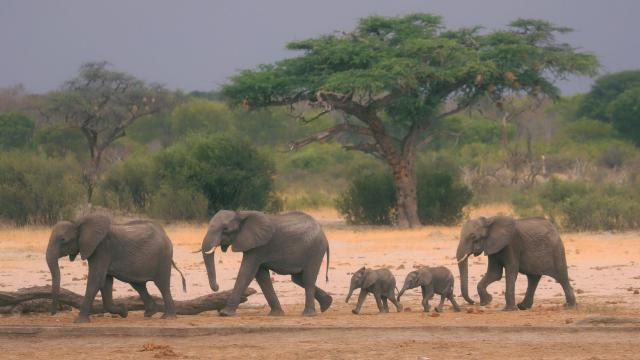An investigation into the effects of ivory poaching has led to the discovery of an increasing number of tuskless female African elephants — the consequences of which aren’t entirely clear.
“The selective killing of species that bear anatomical features such as tusks and horns is the basis of a multibillion-dollar illicit wildlife trade that poses an immediate threat to the survival of ecologically important megafauna worldwide,” opens a new study published on Thursday in Science.
This is sadly true, but as the authors of the new paper also point out, poaching is having the added effect of altering the evolutionary trajectory of species. For the African elephant (Loxodonta africana), this has resulted in the rapid evolution of tusklessness.
Indeed, as biologist Charles Darwin famously pointed out so many years ago, mutation may be random, but selection is most certainly not. Poachers in search of ivory are more likely to pass on an elephant without tusks — a selectional process that’s now favouring this particular adaptation, if it’s fair to call it that.
“Elephants use their tusks for feeding, social interactions, and self-defence,” Shane Campbell-Staton, a co-author of the study and a researcher from the Department of Ecology and Evolutionary Biology at Princeton University, explained in an email. The negative consequences of tusklessness aren’t entirely known, he said, but it could affect the elephants’ feeding and behaviour. The rise of tuskless elephants could subsequently result in downstream ecological effects, as the paper points out.
In their paper, Campbell-Staton and colleagues argue that the Mozambican Civil War, which lasted from 1977 to 1992, served as the primary catalyst of this new evolutionary trend among African elephants. Combattants in this conflict participated in the ivory trade to finance their respective war efforts, resulting in the rapid decline of elephant populations. In Mozambique’s Gorongosa National Park, the elephant population was reduced by approximately 90%, according to the paper.
By analysing historical field surveys and performing population modelling, the researchers connected this period of intense poaching to the increased frequency of tusklessness in female African elephants from the region. Over the 28-year period studied (including the 15 years of civil war), the proportion of tuskless females increased by roughly 30%. The researchers estimate that the relative survival rate of tuskless females during this period was more than five times that of tusked elephants.
Computer models confirmed the results, showing that the emergence of tusklessness was not something likely to occur by chance. These results, the researchers wrote, point to “a heritable genetic basis for tusklessness and an evolutionary response to poaching-induced selection in Gorongosa.”
Because the discovery pointed to a sex-associated genetic origin for tusklessness, the researchers ran genetic tests to find the exact link. This resulted in the discovery of some promising candidates, including the X-chromosome amelogenin gene (AMELX). In humans, mutations to AMELX can result in malformed enamels.
Campbell-Staton was not tremendously surprised by the results.
“I think this study was a great example of deductive hypothesis generation and testing — there were a few surprises, but in large part, we found what we expected,” he said. “But, we expected what we found because we had thought carefully about the logical implications of what we were observing in the field.”
Tusklessness is now a trait that’s found fairly widespread across Africa. But at 1% of all females, it’s still not something that’s happening with tremendous frequency. And with poaching on the decline, the selection pressures for this physical trait are now considerably less intense.
“The elephant population in Gorongosa National Park is currently thriving; the population has nearly tripled over the last 20 years,” said Campbell-Staton. “Over time, we would expect [tusklessness] to become less frequent in the population,” he said, but “that will take generations.”
Writing in an associated Perspectives article, biologists Chris Darimont from the University of Victoria and Fanie Pelletier from the University of Sherbrooke described the scientists’ approach as “elegant.”
“The comprehensive work by [the team] has clearly satisfied the burden of evidence, showing that selective killing can indeed leave a strong evolutionary signature,” wrote Darimont and Pelletier, neither of whom were involved in the new research. “Restoration of the trait and its associated ecosystem function might therefore require longer time scales than those for [physical] changes not associated with genetic changes, an important implication relevant to other systems.”
Indeed, the new paper is a reminder of the extent to which human actions can steer the evolution of species, even across short timescales. Hopefully this is an example of a temporary intrusion, and that tusks will remain a noble fixture among African elephants.
